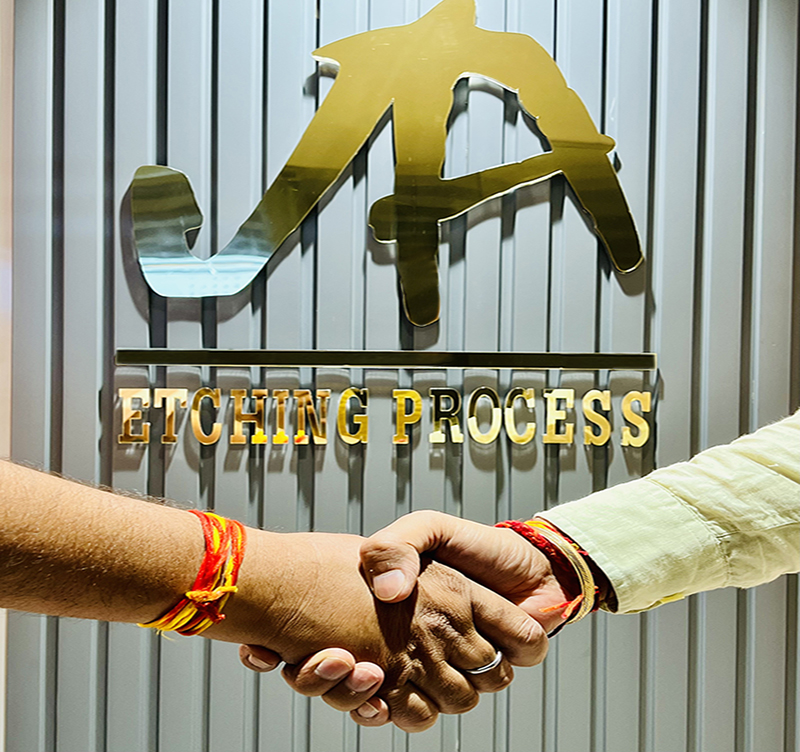Perfection always resides in the details and Jai Ambay Etching Processes is the living embodiment of exactly that. It has risen itself to be the flagship of chemical engraving techniques since it actualises your creative imagination with the newest technology into reality. Its excellent craftsmanship ensures seamless and non-distortion quality in all its artistic works and projects. How do they make this possible? The simple answer is using state-of-the-art technology.
Digital Transfer Technology (DTT)
One such technology that is exclusive to Jai Ambay Etching Processes is the DTT or Digital Transfer Technology. Such a technology helps in utilisation of digital patterns that can be easily printed into Moulds to make identical copies in high resolution.
Laser
Another reason why Jai Ambay Etching Processes stand out is that they use laser texturing. The defining feature of laser texturing is sophistication that becomes achievable because of the smart execution of multiple gloss levels, haptic touch features, the elimination of paint, and optimized scratch performance.
Laser Haze Technology
Laser Haze Technology is a technology that can aid in the specific redirection of the light pattern to manifest some of the finest textures. This is established by creating a fading effect from a specified area of ultra-low gloss to another specified area of ultra-high gloss. Laser Haze functions to create these high and low gloss that helps in creating a variegated surface that has a dancing effect in its finish.
Render-Tech
Furthermore, a novel innovation introduced by the company is Render-Tech that executes the application of a texture to fit perfectly in an uneven surface without allowing the dimension to fall apart.
Gloss Management And Micromatte Technology
The detailing aspect achieves par excellence with Gloss Management. This is the phase wherein the gloss is regulated to a level to ensure optimized performance of the product. A special feature of gloss management is the Micromatte Technology. As the name suggests, such a technology is steered to play down the reflectiveness of plastic that is done to reduce the shine from the overall finish of the product, thus, highlighting its quality.
Rolls
To ensure a uniform complexity to the applications in order to add character to a product, engraved embossing rolls are utilised. Some of the common materials for the rolls to work on are wallpaper, furniture edge veneers, vertical blinds, automotive trim, and vinyl floorings. This is done with enormous detailing while making sure that accuracy, precision, and quality are not compromised. Another factor that facilitates the role of the roll is a strategic design. For example, in order to facilitate the transfer of stock, applying a rough surface can substantially improve the same during the manufacturing process.
Frequently Asked Questions?
Mould texturing is the process of adding texture or patterns to the surface of a mould used in the manufacturing of various plastic or metal parts. It enhances the appearance, functionality, and performance of the final product.
Mould texturing plays a crucial role in creating visually appealing and functional parts. It helps achieve desired aesthetics, such as grain patterns, geometric designs, or textures like leather, wood, or stone. Additionally, it improves functionality by enhancing grip, reducing friction, or promoting proper material flow during the moulding process.
Different materials can be used for mould texturing, depending on the desired texture and the requirements of the application. Common materials include copper, steel, aluminum, or specialized mould texturing materials designed for specific applications.
Yes, existing moulds can be textured through various methods. Depending on the condition and material of the mould, it can be modified or treated to incorporate the desired texture. Skilled professionals or specialized service providers can assist with adding texture to existing moulds.
Mould texturing is beneficial in a wide range of industries, including automotive, consumer goods, electronics, medical devices, packaging, and more. It is used to enhance the appearance and functionality of components, such as interior trim, electronic housings, cosmetic packaging, and appliance parts.


